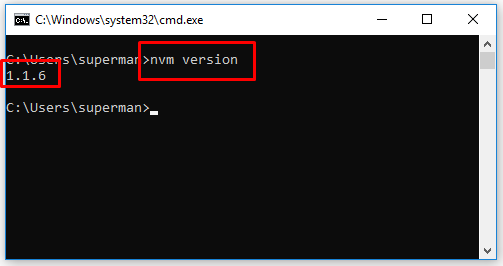

- #Nvm install node v11.4.0 how to
- #Nvm install node v11.4.0 mac os
- #Nvm install node v11.4.0 update
- #Nvm install node v11.4.0 upgrade
- #Nvm install node v11.4.0 software
This used to be a pain, but the node community has come together and created a great solution that lets you easily manage all your node installations and change node versions whenever you feel like it.
#Nvm install node v11.4.0 upgrade
And you will need to upgrade or downgrade your node.js install in order to use it. But nonetheless, sometimes a particular node app will only work with one version of node. For the most part, they’ve done a pretty good job of keeping things compatible the things you write for one version of node will work just as well in the next.
#Nvm install node v11.4.0 software
Joyent, the team behind node.js, has been improving node.js at a frantic pace, to the point where there are multiple releases of the software every month.
#Nvm install node v11.4.0 how to
This is the first in a series of how to install, code in, and use node. As a result, getting up and running with node.js isn’t as easy as, say, getting WordPress up and running on your web server. The downside though is that all these cool new features are really, really new. It’s also really good at handling real-time concurrent web applications, which makes it a great choice for a lot of modern web apps. It lets you write web apps that use Javascript on both the server and the client, so you don’t need to know multiple programming languages to program your website. If you want to know a bit more about node and it’s ecosystem read on.įor those who haven’t heard node.js is, it is the hot new cool kid on the block in web application development. If you already know what Node.js is what it’s for and why it’s cool, then skip straight to the installation directions. How to migrate server data to a supported version.How to upgrade from Ubuntu 14.04 to Ubuntu 16.04.How to upgrade from Ubuntu 12.04 to Ubuntu 14.04.If you are currently operating a server running Ubuntu 12.04, we highly recommend upgrading or migrating to a supported version of Ubuntu: We strongly recommend using a recent article written for the version of Ubuntu you are using. This article may still be useful as a reference, but may not follow best practices or work on this or other Ubuntu releases. Ubuntu 12.04 reached end of life (EOL) on Apand no longer receives security patches or updates. So, I recommended using it to install Node.js and manage that easily.This article is deprecated and no longer maintained. NVM helps us to have some node.js versions together in a machine and use them in our project or test features of dev versions without side effects on our system or project.

nvm use 14.17.5 npm install -global yarn which yarn # ~/.nvm/versions/node/v14.17.5/bin/yarn Conclusion Installing a package on a Node.js installed by NVM is the same as the regular installation of node.js, but the installation of the package is based on version number. nvm use # Found '/path/to/project/.nvmrc' with version # Now using node v14.17.6 (npm v6.14.15) Install a package on Node.js Then you can use the compatible version in other machines of your teammates. nvmrc and you should create it at the root directory of your project. In the Node.js project, you can store the version of Node.js compatible with that in a file, they called it. Or use the latest version nvm use node Uninstall a Node.js versionįinally, If you want to uninstall a version of Node.js, you can use uninstall subcommand for that.įirst, you need to switch to another version with use then you can uninstall that. With this subcommand, you can load Node.js by version number or -lts flag. If you want to load a specific version, use use subcommand. Now you install some versions of Node.js on your machine So you can see the list of installed versions with list or ls subcommand. nvm install node Load a specific version of Node.js Or you can install the latest version with node instead of version number. If you want to install the LTS version you can use -lts instead of version number. You can install a specific version by nvm with install subcommand. Install a version of Node.jsįirst, you can get the list of available versions by list-remote or ls-remote subcommand. We want to choose some important subcommands and explain them. Nvm has a lot of subcommands such as install, use, uninstall, and more. Now you need to close and reopen the terminal to load nvm, then check and verify your installation nvm -version # 0.38.0

"$NVM_DIR/nvm.sh" # This loads nvm bash_completion & \. export NVM_DIR="$HOME/.nvm" # This loads nvm & \. curl -o- | bashĪfter that, the installer will clone the nvm repository into ~/.nvm/ directory and you should add some lines below at the end of ~/.bashrc file to load nvm. So, you can use curl to download then run it with bash with the command below in the terminal. When I wrote this article, the latest version of nvm installer was 0.38.0.
#Nvm install node v11.4.0 update
There’s some way to install or update nvm on your machine, but I prefer to install nvm with the installer script.
#Nvm install node v11.4.0 mac os
Photo by Ian Dooley on Unsplash Install nvm on Ubuntu and Mac OS


 0 kommentar(er)
0 kommentar(er)
